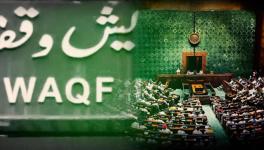Hypocrisy of BJP: Hijab Intrudes in Secular Schools, but Gita is Welcome

Image Courtesy: AFP
In 2018, the National Council of Educational Research and Training (NCERT), tasked to assist and advise central and state governments over school education, shared a manual on sensitising schools to the needs of minority students. Rereading this manual against the Karnataka government’s recent decision to introduce the Gita in the school curriculum reveals the great hiatus between stated goals and the situation on the ground.
The Karnataka government’s decision came a day after Gujarat, where too the BJP is in power, declared schools will teach the Gita from the next academic year. It is crystal clear that these decisions reflect a faulty understanding of history, in which it is presumed India has been a Hindu state since time immemorial. This kind of history invisibilises Jainism, Buddhism, Ajivikas and other faiths and communities that flourished here. The Zoroastrian, Jewish, Christian and Muslim communities are also relegated to the sidelines by such a view of history.
The arbitrary decision of the Karnataka government, taken without consultation, also reflects its selective amnesia. Several members of the BJP rationalised the prohibition on the hijab by arguing that religious symbols have no place in a school. While advocating the ban on the hijab, neither party nor government remembered that their push to separate religion from education rang of hypocrisy. The metamorphosis of die-hard proponents of Hindu Rashtra into ‘secular warriors’ was an amazing sight, but days later, they brought the focus on a Hindu religious text, and now they are silent on whether religion has a place in schools.
The amnesia of state governments is virtually unlimited. It superimposes the will of Hindutva even over constitutional provisions that strictly oppose mixing religion and education. Legally, the position is that government-aided educational institutes, including schools, must not teach religion. When it came to the Gita, it seems the Karnataka government decided to forget recent high court judgements that have upheld the right to freedom of conscience.
The Gita is being introduced in the moral science curriculum in schools, which raises another fundamental question. The conflict here is between the mutually-contradictory goal of education and religious scriptures. Rabindranath Tagore said education dispels ignorance and ushers in the ‘light of knowledge’. Education facilitates learning; or the acquisition of knowledge, information, values, beliefs, habits and skills. Learning starts from infancy and includes formal and informal interactions, initially with caregivers and then grows to include institutions. Education, therefore, has no end. Its goal is to dispel ignorance. This vision is contrary to what religions stand for. Religions speak of ultimate truths, the supremacy of gods, and urge students to pay obeisance, not raise questions. So, when scriptures enter educational institutes, it defeats the purpose of education.
Second, teaching a religious text in a multi-religious, formally secular country is not the same as studying religion in a historical or sociological sense. At another time, one could have asked whether scriptures have any place in schools—but today, it would be seen as an affront. That apart, it is vital to understand religion and philosophy and their ebb and flow through time. Irrespective of faith or belief, students must learn about the genesis of faith to understand how the modern autonomous individual with the ability to reason came to exist. Today, the emerging worldwide consensus is that religion is a personal affair, in which no external agency has a role. How human civilisation arrived here is also a necessary aspect of education.
Third, in the decision to teach the Gita in schools, there is a tacit acceptance of the misconception that religion makes people moral. Morality or ethical behaviour is nothing but deciding what is ‘good’ or ‘bad’, which are notions that change with time and place. In fact, the limited studies available on the role of religious instruction in making people moral are inconclusive or, at best, ambiguous in what they found. It would seem that believers tend to view the doubter or atheist with suspicion. A non-believer is often considered the ‘other’ who does not fear god or the afterlife or is simply devoid of sacred teachings that ‘show the way’. Those who wholeheartedly embrace the idea that religion imposes a universal moral code—and therefore feel that religious instruction has a place in the school curriculum—conveniently forget that people have been killed in the name of religion since antiquity. Burnings at the stake, ethnic cleansing, the crusades and sects that pronounce orders to exterminate the ‘other’ are a part of recorded history. History is filled with religious conflicts.
Scholars have found that many faithful people engage in more moral behaviour with members of their group, but their moral compass weakens when interacting with members of another faith. One detailed examination of the philosophical debates on this issue concluded that “...some aspects of ‘religion’ may promote some aspects of ‘morality’, just as others serve to suppress or obstruct the same, or different, aspects. In short, in discussing whether religion is a force for good, we must be very clear what we mean by ‘religion’ and what we mean by ‘good’.
Fourth, religious scriptures in the curriculum are problematic because they advocate hierarchies—including the graded order of caste in India—and some may even promote violence. Recall the 15th-century German theologian Martin Luther, who battled the Roman Catholic Church but was antisemitic. Centuries later, the Nazi party used his views to justify the Holocaust. Education must teach critical thinking and how to build harmonious relationships. Religious teachings are not the way to get there. Remember what Mirza Ghalib wrote: ‘Man went out in search of truth and when he tired in his quest, he set up temples, mosques and churches.’
The author is a freelance journalist. The views are personal.
Get the latest reports & analysis with people's perspective on Protests, movements & deep analytical videos, discussions of the current affairs in your Telegram app. Subscribe to NewsClick's Telegram channel & get Real-Time updates on stories, as they get published on our website.
























